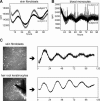The period length of fibroblast circadian gene expression varies widely among human individuals
- PMID: 16167846
- PMCID: PMC1233413
- DOI: 10.1371/journal.pbio.0030338
The period length of fibroblast circadian gene expression varies widely among human individuals
Abstract
Mammalian circadian behavior is governed by a central clock in the suprachiasmatic nucleus of the brain hypothalamus, and its intrinsic period length is believed to affect the phase of daily activities. Measurement of this period length, normally accomplished by prolonged subject observation, is difficult and costly in humans. Because a circadian clock similar to that of the suprachiasmatic nucleus is present in most cell types, we were able to engineer a lentiviral circadian reporter that permits characterization of circadian rhythms in single skin biopsies. Using it, we have determined the period lengths of 19 human individuals. The average value from all subjects, 24.5 h, closely matches average values for human circadian physiology obtained in studies in which circadian period was assessed in the absence of the confounding effects of light input and sleep-wake cycle feedback. Nevertheless, the distribution of period lengths measured from biopsies from different individuals was wider than those reported for circadian physiology. A similar trend was observed when comparing wheel-running behavior with fibroblast period length in mouse strains containing circadian gene disruptions. In mice, inter-individual differences in fibroblast period length correlated with the period of running-wheel activity; in humans, fibroblasts from different individuals showed widely variant circadian periods. Given its robustness, the presented procedure should permit quantitative trait mapping of human period length.
Figures





References
-
- Schibler U, Sassone-Corsi P. A web of circadian pacemakers. Cell. 2002;111:919–922. - PubMed
-
- Duffy JF, Rimmer DW, Czeisler CA. Association of intrinsic circadian period with morningness-eveningness, usual wake time, and circadian phase. Behav Neurosci. 2001;115:895–899. - PubMed
-
- Toh KL, Jones CR, He Y, Eide EJ, Hinz WA, et al. An hPer2 phosphorylation site mutation in familial advanced sleep-phase syndrome. Science. 2001;291:1040–1043. - PubMed
Publication types
MeSH terms
LinkOut - more resources
Full Text Sources
Other Literature Sources
Medical
Research Materials

